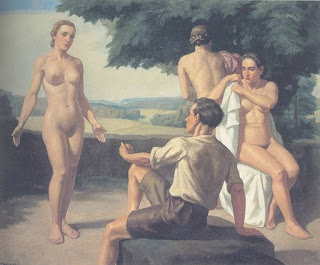The Male Gaze in Fine Art
These differences in gender roles between men and women stem from something deeper than the male gaze, which is known as patriarchy. Patriarchy as described by Bell Hooks in his book, “Understanding Patriarchy,” is a “Political system” that promotes men being “dominating, and superior to everyone deemed weak, especially females” (Hooks 2). He goes on by insisting that this political system of male domination is determined from the time a man and women are born. Patriarchy is a concept that has been fed to us by our “parents” either unknowingly or knowingly, because it is how they have been taught to view the world. Another important factor that promotes the unfair treatment of women is the “church” because it teaches men to “rule the world”, and for “women to help men perform these tasks” (Hooks 2). This is a common example of the patriarchy that reinforces damaging standards for men and women because it belittles women and discourages men from seeming “weak.” In Hooks’ writing she claims that her brother was praised for being violent because as a “boy it was a good thing,” but she was scorned for showing “rage” because it was not an “appropriate feminine feeling” (Hooks 2).Hooks’ portrayal of her early childhood suggests that society encourages the stereotypes within gender roles that leaves men and women at a disconnect.
As a youth who grew up in a religious family, I was constantly being prodded by my relatives to act in a way that fit the role of a man. Although I was unaware that their attempts to shape my behavior was a result of the patriarchy they grew accustomed to, I was still somehow aware of the pressure being put on me to act as if I was someone else. I remember being taught lessons from the
bible by my parents and only learning about men who played important roles in biblical times and not studying women at all. Berger’s book, “The Male Gaze,” and Hooks’ writing, “Understanding Patriarchy” have reshaped my view on how women are portrayed in America. It is clear that women are still victims of the male gaze because they are being made to fit high beauty standards in the media, and in their daily lives. Patriarchy is another toxin to the role women play in society because it allows for them to be made subservient in relation to men who are made dominant. In order for this mistreatment of women to stop in society, we must stop accepting the stereotypes that divide genders in society. We cannot preach of equality in government and later condemn women for being themselves. The truest form of equality will only be established in today's society when we look past the standards that dictate the lives of men and women, and view them as equal human beings instead.
-Vladimir Massillon

No comments:
Post a Comment
Note: Only a member of this blog may post a comment.